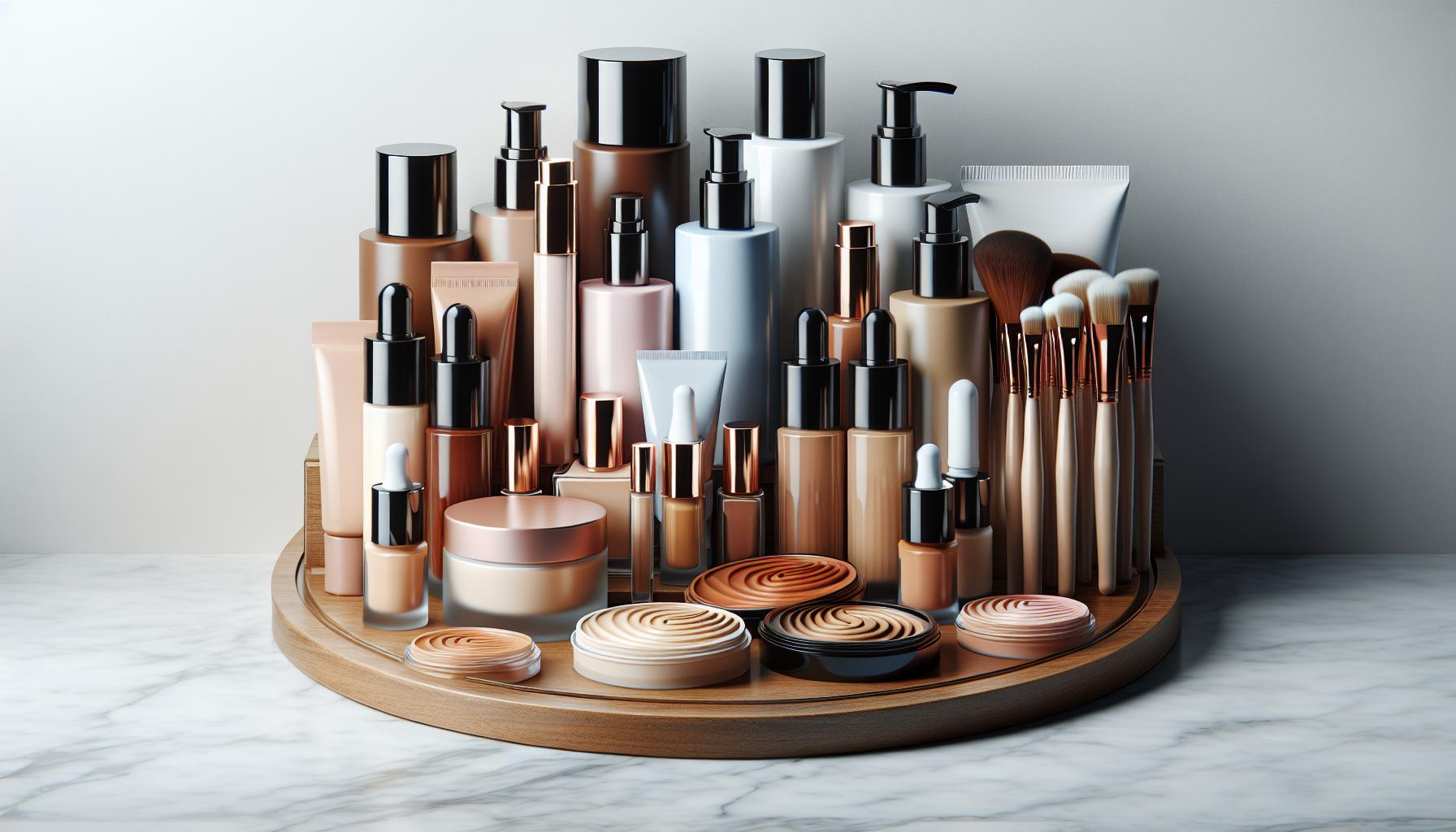Understanding the Causes of Dark Spots
Before diving into how you can effectively conceal dark spots, it’s vital to understand what causes them in the first place. This knowledge not only helps in choosing the right products but also in applying them in a way that addresses the root of the issue.
Dark spots, also known as hyperpigmentation, can be attributed to a variety of factors. The most common causes include:
- Sun Exposure: Prolonged exposure to the sun’s UV rays can increase melanin production, leading to dark spots.
- Age: With age, the distribution of melanin can become less even, causing age spots.
- Hormonal Changes: Fluctuations in hormones, especially during pregnancy or with the use of birth control pills, can trigger melasma.
- Inflammation: Post-inflammatory hyperpigmentation can occur after an injury or skin condition, such as acne or eczema.
- Genetics: Sometimes, predisposition to hyperpigmentation is simply a matter of genetics.
Here’s a brief overview of the primary causes:
| Cause | Description |
|---|---|
| Sun Exposure | Increases melanin production, leading to dark spots. |
| Age | Leads to uneven distribution of melanin. |
| Hormonal Changes | Can trigger melasma. |
| Inflammation | Post-inflammatory hyperpigmentation. |
| Genetics | Predetermined predisposition to hyperpigmentation. |
“Understanding the root cause of your dark spots is the first step towards effective concealment.”
By recognizing what factors contribute to your specific situation, you can tailor your skincare and makeup choices to not just conceal but also treat and prevent further dark spots. Continuously protect your skin from sun damage with a high SPF sunscreen, and consider treatments that target the underlying cause, such as topical retinoids for age-related concerns or vitamin C serums for overall brightness and spot reduction.
Identifying the Right Products for Your Skin Type

Knowing your skin type is crucial in selecting the perfect concealers and treatment products for dark spots. Each skin type reacts differently to various formulations; hence, understanding yours can help prevent further irritation or breakouts.
For oily skin, look for products labeled “non-comedogenic” to avoid clogging pores. Mineral-based concealers work well as they absorb excess oil, giving you a matte finish.
If you have dry skin, select creamy concealers and treatments rich in hydrating ingredients like hyaluronic acid. This ensures your skin stays moisturized, preventing the concealer from flaking.
Those with sensitive skin should opt for products free from fragrances, parabens, and alcohol, as these can cause irritation or allergic reactions.
Here’s a quick guide to help you choose:
| Skin Type | Concealer Type | Ingredients to Look For |
|---|---|---|
| Oily | Mineral-based | Salicylic acid, Zinc Oxide |
| Dry | Creamy, Hydrating | Hyaluronic Acid, Glycerin |
| Sensitive | Fragrance-free | Aloe Vera, Niacinamide |
Tip: Always patch test a new product before applying it to your face to ensure there are no adverse reactions.
Remember, the goal is not only to conceal but also to treat. Look for products with ingredients like vitamin C, retinoids, or niacinamide, which are known for their skin-brightening and healing properties.
The right concealer can do wonders in masking dark spots but pairing it with targeted treatments will provide a long-term solution to achieving a clearer, more radiant complexion.
Choosing the Perfect Shade of Concealer
When it comes to concealing dark spots, selecting the perfect shade of concealer is crucial. You might think grabbing the closest match to your skin tone is the way to go, but there’s a bit more nuance to it. For dark spots, you actually want to choose a concealer that’s one to two shades lighter than your natural skin tone. However, avoid going too light, as this can make the spots appear gray.
Here’s a quick guide to help you find your ideal concealer shade:
| Skin Undertone | Recommended Concealer Shade |
|---|---|
| Cool | Slightly pink or peachy |
| Warm | Golden or yellow tones |
| Neutral | Beige with no obvious undertone |
Remember, the goal is to neutralize the color of the dark spots, not just cover them up. For deeper skin tones, a peach or orange-tinted concealer works wonders in canceling out the darkness. Lighter skin tones may benefit from a light peach or pink concealer.
Pro Tip: “Always test concealer in natural lighting,” says professional makeup artist Alex Rivera. “What looks good in the store can look very different in daylight.”
After choosing your shade, apply the concealer directly onto the dark spots and gently blend outwards. The key is blending; you want the product to seamlessly merge with your skin for a natural look. For the best results, set the concealer with a translucent powder to ensure it stays in place throughout the day.
Remember, while it’s important to cover up those pesky dark spots effectively, it’s equally crucial to treat them. Keep using products with Vitamin C, Retinoids, or Niacinamide to not only conceal but also lighten these spots over time.
Preparing Your Skin for Concealing
Before you dive into concealing those pesky dark spots, it’s crucial to ensure your skin is primed and ready. Proper preparation can drastically improve the appearance of your concealer, making it look natural and long-lasting.
Start with a clean slate by cleansing your face to remove any dirt, oil, and impurities. A gentle, hydrating cleanser is your best bet, especially if you’ve got sensitive or acne-prone skin. After cleansing, don’t skip on moisturizing. Hydrated skin provides a smooth base for makeup application. Look for a moisturizer that suits your skin type – this little step can make a significant difference.
Prime Time
Using a primer is a game-changer for concealing dark spots effectively. Primers not only smooth out the skin’s texture but also help in making your concealer cling better to the skin. They can offer additional benefits, such as:
- Color Correction: Some primers come with color-correcting properties. Green tones down redness, while peach or orange tones are perfect for dark spots on medium to deep skin tones.
- Pore Minimization: Helps in blurring out large pores for a smoother look.
- Longevity: Enhances the durability of your makeup throughout the day.
Here’s a quick look at how primer benefits stack up:
| Benefit | Description |
|---|---|
| Texture Smoothing | Creates a silky base for easier makeup application. |
| Color Correction | Neutralizes discolorations for a more unified skin tone. |
| Increased Durability | Keeps makeup intact longer, resisting sweat and oil. |
Remember, a light hand is essential. Applying too much primer can actually worsen the look of your concealer, causing it to slide off or look cakey. Just a pea-sized amount is enough to cover your entire face, focusing on areas with dark spots.
Applying and Blending Concealer Correctly
Once your skin is prepped and primed for action, it’s time to move on to concealer — the MVP in your fight against dark spots. Finding the right concealer and applying it correctly can make all the difference. Match the concealer to your skin tone for areas without hyperpigmentation, and use a color corrector underneath for darker areas. Peach or orange tones are typically recommended for darker skin spots.
Choosing the Right Concealer
| Skin Tone | Recommend Concealer Shade |
|---|---|
| Light | 1-2 shades darker with peach undertones |
| Medium | True match or peach |
| Dark | Orange or red undertones |
Application Tips
- Dab, Don’t Drag: Use a small concealer brush or your fingertip to lightly dab the concealer onto the dark spots. Avoid dragging the product across your skin which can cause uneven coverage.
- Layer Wisely: If you’re using a color corrector, apply it before your skin-tone concealer. Allow each layer to dry a bit before applying the next. This prevents mixing and ensures maximum coverage.
“Blending is the key to flawless concealer application. Always tap, never rub.” – Every Makeup Artist Ever
Blending for a Natural Look
Blending concealer is essential for a natural, flawless look. Use a damp beauty sponge to gently tap over the area where you’ve applied your concealer and color corrector. This tapping motion helps the product melt into your skin and disguise those pesky dark spots. For stubborn areas, you might need to go back with a tiny brush to add a bit more concealer and blend again.
Remember, the goal is to achieve a balance where your dark spots are concealed without your makeup looking heavy or cakey. Light layers and careful, patient blending are paramount.
Setting Your Concealer for Long-Lasting Wear
Once you’ve expertly concealed your dark spots, it’s crucial to set your concealer to ensure it stays in place all day. Without this step, you risk your hard work sliding off or creasing, especially in areas where your skin produces more oil.
Use a Setting Powder
A light application of setting powder can lock your concealer in place, offering a matte finish that lasts. For the best results, choose a setting powder that matches your skin tone or is translucent to avoid altering the color of your concealer.
- Tip: Use a fluffy brush to apply the setting powder with a light hand for even coverage.
Setting Spray Options
For extra durability, consider applying a setting spray after your makeup routine. Setting sprays help in keeping your makeup looking fresh and can provide a more natural finish compared to powder alone.
| Setting Spray Type | Benefit |
|--------------------|----------------------|
| Matte | Reduces shine |
| Dewy | Adds a glow |
| Long-Wearing | Extends makeup wear |
Balancing Durability with Naturalness
Achieving long-lasting wear without your makeup looking heavy is all about balance. Focus on applying products lightly and only where needed.
“Less is often more when it comes to setting your makeup. A targeted approach ensures it lasts while looking as natural as possible.”
Remember, the goal is to secure your concealer so your confidence remains as strong in the evening as it was when you first applied your makeup. Adjust your technique based on your daily activities and the weather to find the perfect balance that works for your skin.
Targeting Specific Types of Dark Spots
When you’re up against dark spots, understanding the type you’re dealing with can make all the difference in how effectively you can conceal them. Different treatments and concealers work better for specific kinds of discoloration, so let’s break down the most common types.
Melasma
Commonly triggered by hormonal changes, melasma presents as large patches of dark spots. It requires a gentle yet effective approach to both treatment and camouflage.
Sun Spots
Also known as age spots, these are typically found on areas most exposed to the sun, like your face and hands. Using a concealer with SPF can provide both coverage and protection.
Acne Scars
These spots are leftovers from previous battles with acne. They can be more stubborn and might need a color-correcting base before applying your concealer.
To give you a clearer picture, here’s a quick breakdown of these types and effective concealment strategies:
| Type | Characteristic | Concealment Strategy |
|---|---|---|
| Melasma | Large, dark patches | Gentle application |
| Sun Spots | Dark spots on sun-exposed areas | Concealer with SPF |
| Acne Scars | Uneven, stubborn spots | Color-corrector then concealer |
Remember, preparation is key. No matter the type of dark spot you’re addressing, starting with a well-moisturized skin and using a primer tailored to your needs will lay the perfect groundwork for concealment.
“Perfect makeup begins with perfect skin preparation.”
With the right tools and techniques, you’re well on your way to not just covering up those dark spots, but also boosting your skin’s overall health and appearance.
Additional Tips and Tricks for Flawlessly Concealing Dark Spots
In your quest for a flawless complexion, you’ve learned how to pick the right products and apply them effectively. But even with these skills, there might be days when dark spots seem more stubborn than usual. Don’t worry; armed with these additional tips and tricks, you’ll have everything you need to achieve that perfect cover-up.
First off, don’t underestimate the power of hydration. Well-hydrated skin doesn’t just look healthier; it’s also a smoother canvas for makeup application. Consider products containing hyaluronic acid, known for locking in moisture.
“The key to a smooth makeup application is a well-moisturized face. Dry patches will only highlight imperfections,” notes makeup artist Jane Doe.
In terms of concealer, layering is your friend, but remember, less is often more. Start with a thin layer of color corrector, followed by your concealer. If you still see dark spots, add another thin layer of concealer until you’ve achieved the desired coverage.
Don’t forget to blend, blend, blend. Use a damp makeup sponge for the most natural look. It’s not just about hiding those spots; it’s about making sure they’re invisible under a seamless blend of makeup.
Finally, let’s break down the impact of these tips with a simple chart:
| Tip | Benefit |
|---|---|
| Hydration | Creates a smoother canvas for makeup. |
| Layering | Allows for customizable coverage without caking. |
| Blending with Sponge | Achieves a natural, airbrushed finish. |
By incorporating these strategies into your routine, you’re not just concealing dark spots; you’re enhancing the overall appearance of your skin. Remember, the goal is a radiant, healthy-looking complexion that feels just as good as it looks.
Conclusion
Choosing the Right Products
Selecting the right products is as vital as the technique you use. Always opt for a color corrector that neutralizes dark spots effectively. Peach or orange-toned correctors are typically best for lighter skin tones, while red or terracotta shades suit darker skin tones better. Non-comedogenic and hydrating concealers are preferable to avoid clogging pores and to promote a smoother application.
Remember, not all products work the same for everyone. It might take some trial and error to find what best suits your skin.
| Product Type | Skin Tone Suggestion |
|--------------------|--------------------------|
| Peach Corrector | Light to Medium Skin |
| Orange Corrector | Medium to Dark Skin |
| Red/Terracotta | Darker Skin Tones |
Did You Know?
“Makeup is not just covering, it’s healing and protecting your skin in the process.”
Incorporating Skincare
Before you even reach for makeup, skincare plays a critical role in how successfully you can conceal those pesky dark spots. A well-hydrated and moisturized skin not only looks healthier but also creates an ideal canvas for makeup application.
- Regular exfoliation helps to shed dead skin cells, promoting a more even skin tone.
- SPF is non-negotiable. Daily sunscreen usage prevents further darkening of spots and protects against harmful UV rays.
Remember, beautifully concealed skin starts with the skin beneath the makeup. Keep your skin hydrated, protected, and primed to enhance the efficiency of your concealing technique.




